
Posted on 09/15/2012 4:58:25 AM PDT by Homer_J_Simpson

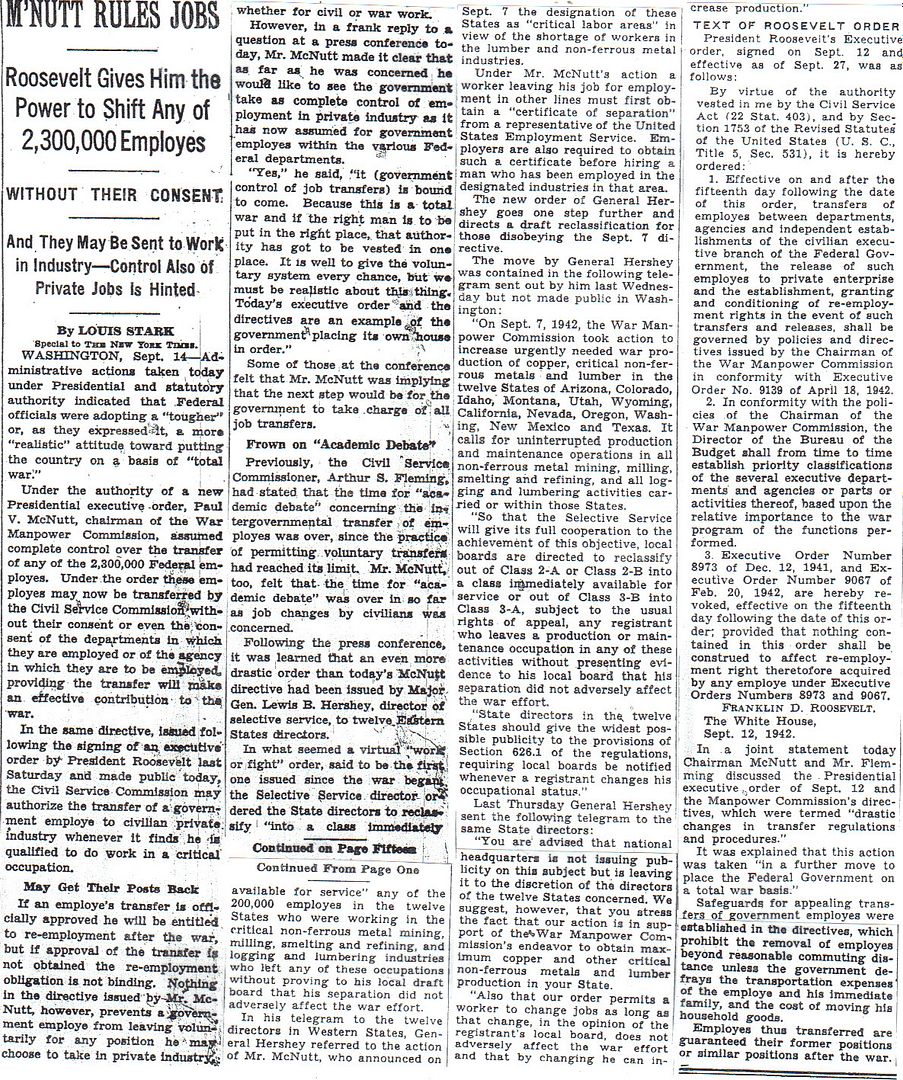
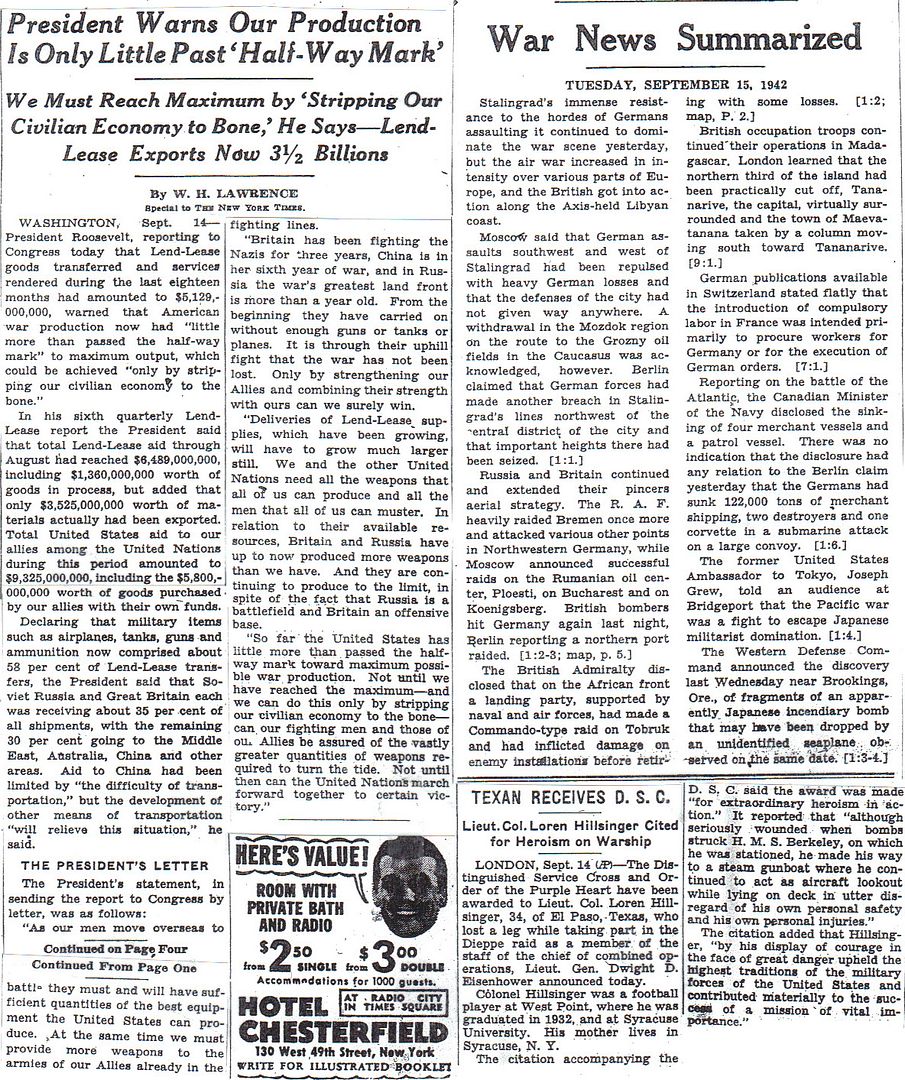
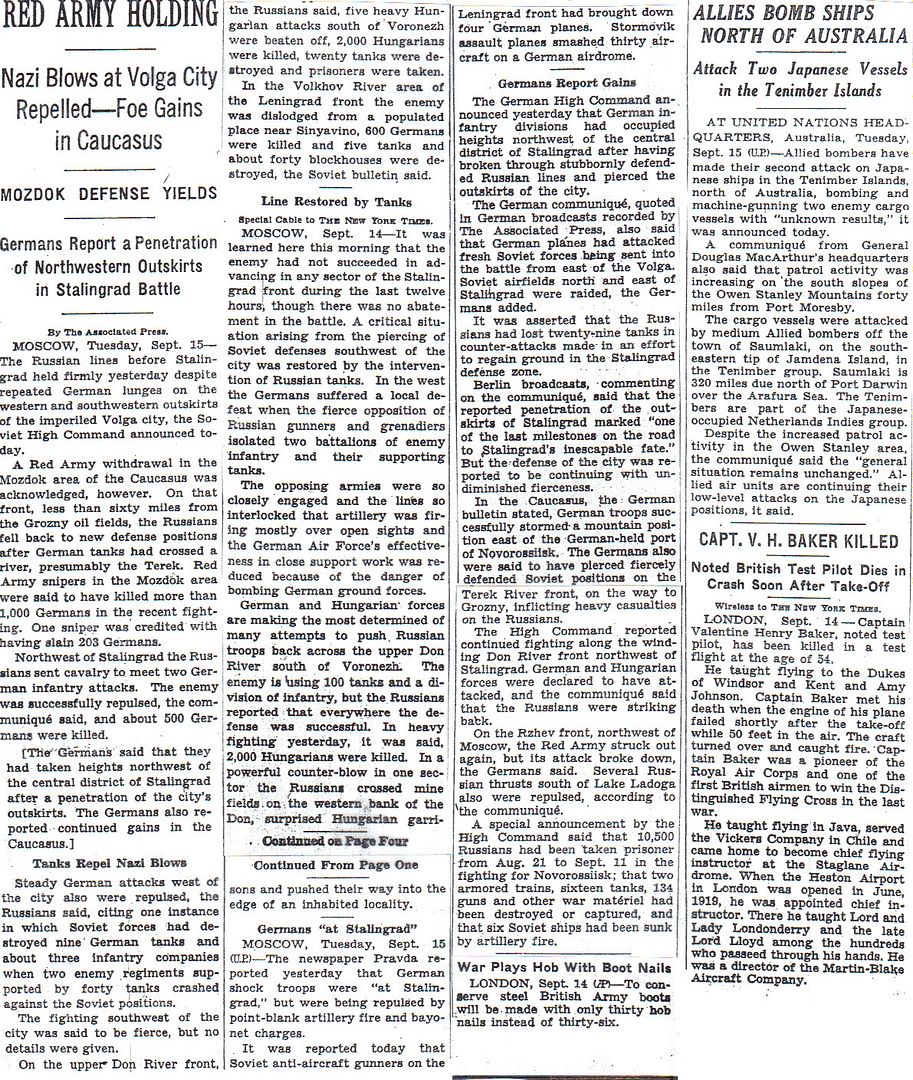
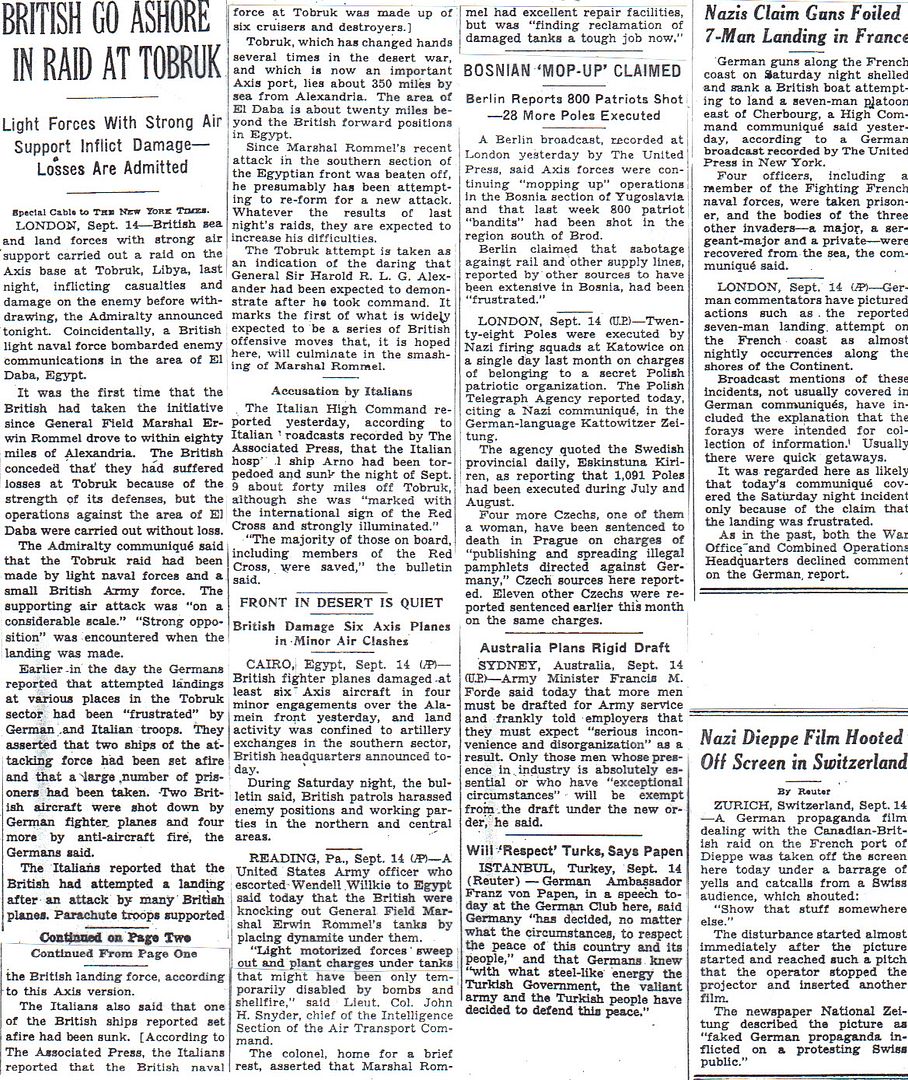
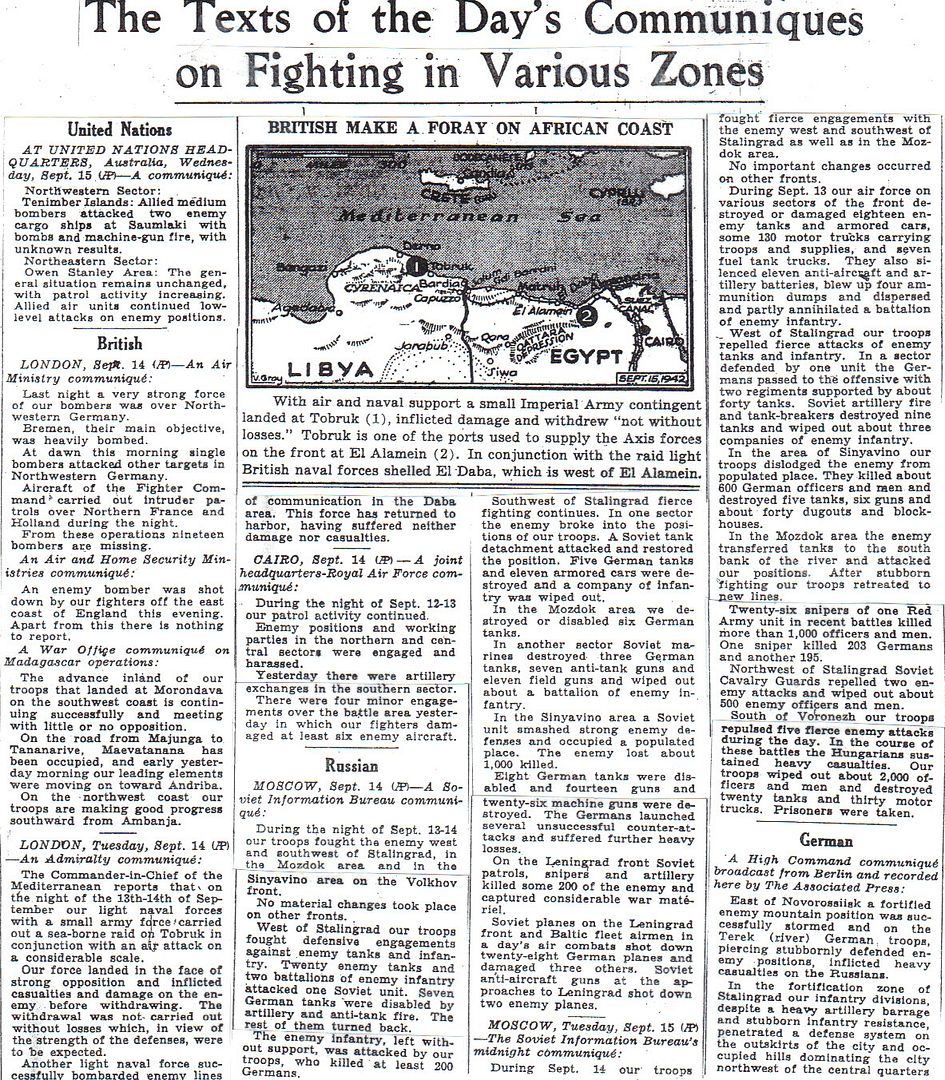
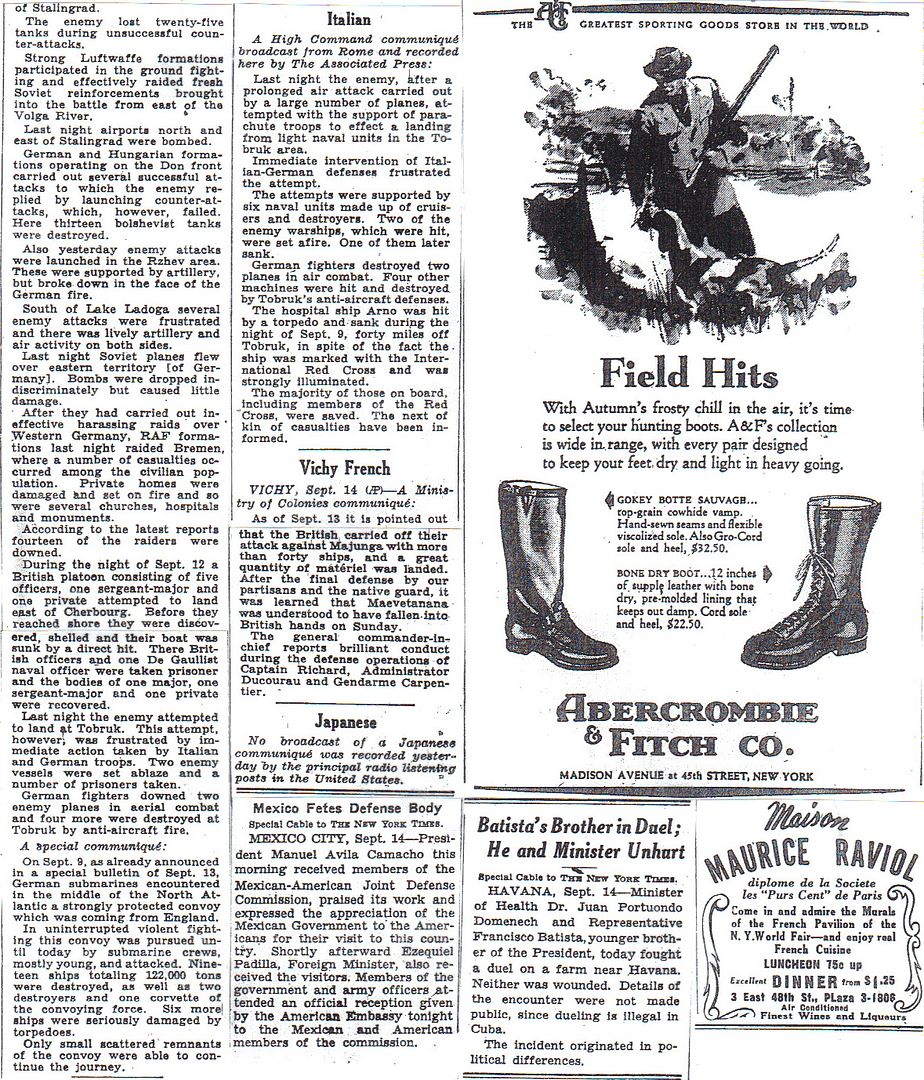
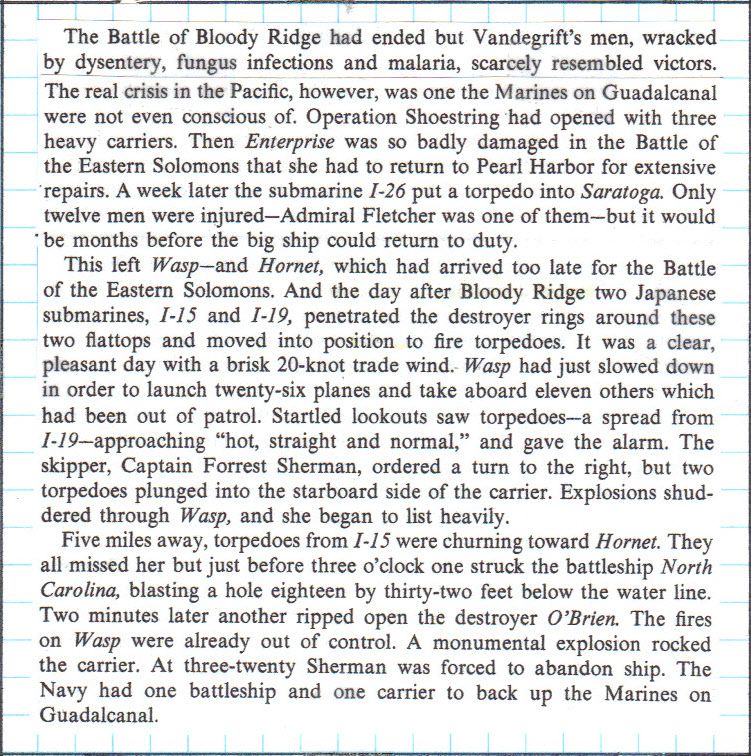
John Toland, The Rising Sun: The Decline and Fall of the Japanese Empire, 1936-1945
http://www.onwar.com/chrono/1942/sep42/f15sep42.htm
Stalingrad street fighting rages
Tuesday, September 15, 1942 www.onwar.com
On the Eastern Front... In Stalingrad, fighting rages in the main railway station.
In the Solomon Islands... Offshore at Guadalcanal, the Japanese submarine, I-19 sinks the USS Wasp with three torpedoes, also damaging the battleship USS North Carolina. A destroyer is sunk as well.
M’Nutt?? Did they run out of little c’s or was their headline moonlighting from VARIETY?
http://homepage.ntlworld.com/andrew.etherington/frame.htm
September 15th, 1942
UNITED KINGDOM: Destroyer HMS Brissenden launched. (Dave Shirlaw)
MEDITERRANEAN SEA: A lone US Army, Middle East Air Force B-24 drops 1 bomb on a tanker in Suda Bay, Crete. B-24s bomb behind the enemy lines while P-40s, along with the RAF, fly escort and carry out a scramble missions over the area west of El Alamein, Egypt. (Jack McKillop)
GERMANY: U-863 laid down. (Dave Shirlaw)
U.S.S.R.: There is fierce fighting between German and Soviet forces for possession of Mamayev Kurgan, the strategic hill overlooking Stalingrad. (Jack McKillop)
NEW GUINEA: A reinforced infantry company of the U.S. Army’s 126th Infantry Regiment, 32d Infantry Division, is airlifted from Brisbane, Queensland, Australia, to Port Moresby by USAAF transport aircraft. These is the first U.S. infantry unit in New Guinea. (Jack McKillop)
In the air, US 5th Air Force B-25s and B-26s hit Buna and Sanananda and attack camps at Efogi and Myola. on New Guinea; and the first US infantry troops, elements of the 32d Infantry Division, arrive at Port Moresby. (Jack McKillop)
BISMARCK ARCHIPELAGO: In the air, USAAF 5th Air Force B-17s bomb the harbor and airfields at Rabaul on New Britain Island. (Jack McKillop)
SOLOMON ISLANDS: The USN’s Task Force 18 is escorting the transports carrying the 7th Marine Regiment to Guadalcanal. TF 18 is built around the aircraft carrier USS Wasp (CV-7) and the battleship USS North Carolina (BB-55), was sighted and attacked by the Japanese submarines HIJMS I-16 and HIJMS I-19.
At 1444 hours, a spread of 4 torpedoes from the IJN submarine HIJMS I-19 were fired; 2 hit the USS Wasp in the vicinity of gasoline tanks and magazines and 1 hits the battleship USS North Carolina. A fourth torpedo, probably from HIJMS I-16, hits the destroyer USS O’Brien. USS North Carolina took the torpedo portside, 20 feet (6.1 meters) below her waterline, and 6 of her men were killed. A 5.6 degree list was righted in as many minutes, and she maintained her station in a formation at 26 knots.
At 1452 hours, the destroyer USS O’Brien (DD-415) sighted smoke coming from Wasp. As a member of Hornet’s ASW screen she made an emergency turn to the right. At about 1454, while accelerating and swinging right, her lookouts spotted a torpedo two points forward of the port beam 1000 yards (914 meters) away. This torpedo missed close astern, but while attention was concentrated on it another torpedo hit the port bow. The explosion did little local damage, but set up severe structural stresses through the ship but she was able to proceed under her own power.
The aircraft carrier USS Wasp was the most severely damaged. Fires broke out almost simultaneously in the hangar and below decks and the heat of the intense gasoline fires detonated the ready ammunition at the forward antiaircraft guns on the starboard side, and fragments showered the forward part of the ship. The number two 1.1-inch (27.9 mm) mount was blown overboard. Water mains in the forward part of the ship proved useless, since they had been broken by the force of the explosions. There was no water available to fight the conflagration forward; and the fires continued to set off ammunition, bombs, and gasoline. As the ship listed to starboard between 10 and 15 degrees, oil and gasoline, released from the tanks by the torpedo hit, caught fire on the water. A serious gasoline fire broke out in the forward portion of the hanger, within 24 minutes of the initial attack, three additional major gasoline vapor explosions occurred. Unable to control the fires, the “abandon ship” order was given at 1520 hours. The abandoned ship drifted and the fires traveled aft; four more violent explosions boomed as night began to fall. The destroyer USS Lansdowne (DD-486) drew the duty of destruction, and she fired five torpedoes into the dying ship’s fire-gutted hull. Three hit, but she remained afloat. By now, the orange flames had enveloped the stern. The carrier literally floated in a burning pool of gasoline and oil. She sank at 2100 by the bow. (Jack McKillop)
TERRITORY OF ALASKA: ALEUTIANS: The US 11th Air Force dispatches a B-17 Flying Fortress and a B-24 Liberator to fly armed reconnaissance over Kiska Island, and at Amchitka Island blast buildings in the Constantine Harbor area; fighters strafe Kiska Island Camp area and down 4 intercepting aircraft. (Jack McKillop)
CANADA: Minesweeper HMCS Westmount commissioned.
Support vessel HMCS Avalon III ex-ZIG ZAG.
Tug HMCS Grenville assigned to Sydney, Nova Scotia.
Minesweeper HMCS Truro arrived Halifax from builder Quebec City, Province of Quebec.
Corvettes HMCS Louisburg, Prescott and Woodstock departed St. John’s for UK with Convoy HX-207 and support of Operation Torch, the North African Landings
Fairmile depot ship HMCS Provider launched Sorel, Province of Quebec
(Dave Shirlaw)
U.S.A.: Marine Photo squadrons VMD-1 and VMD-2 are redesignated VMD-154 and VMD-254 respectively. One squadron was scheduled to deploy to the Solomon Islands and since VMD-254 was further along in training, the squadrons exchanged designations, i.e., VMD-154 became VMD-254 and vice-versa. (Jack McKillop)
Destroyers USS Pringle, Gherardi commissioned.
Escort carrier USS Altamaha commissioned.
Destroyer escort USS Tomich laid down.
Destroyers USS Maddox and Nelson launched.
Minesweeper USS Zeal launched.
(Dave Shirlaw)
ATLANTIC OCEAN: The German submarine U-261 is sunk west of the Shetlands, in position 59.50N, 09.28W, by depth charges from a Whitley of No 58 Squadron based at Stornoway, Hebrides Islands. All 43 hands on the U-boat are lost. (Jack McKillop)
U-506 along with U-156 and U-507 and Italian submarine Cappellini took part in the rescue operations after the sinking of SS Laconia in September 1942 off Africa. About 1500 men were saved by these boats and French ships from Dakar (which arrived on Sept 16, 4 days after the sinking).
U-517 sank SS Inger Elisabeth and Saturnus in Convoy SQ-36.
U-68 sank SS Breedijk.
U-514 sank SS Kioto.
U-515 sank SS Sörholt.
(Dave Shirlaw)
I like how they published transcripts of radio broadcasts from all of the countries.
That "DRAFT" order tells you how desperate things were ~
For years and years when I"d go into Postal Headquarters I"d pass by a bronze plaque filled with hundreds of names ~ many of them the names of fellows killed in WWII.
These were Postal Headquarters and DC post office guys who were REASSIGNED per the provisions of that draft order to post office field operations at, near, on, under, or inside the various fronts ~ Atlantic and Pacific, or in the Merchant Marine.
It was real ~ one day you were on the job in a post office and the next you were under fire armed only with the Postal Manual. These were considered highly important jobs.
They apparently didn’t have Mac and Mc in large type. Note how the headlines always say “M’Arthur.”

DURING the night of 17th/18th September Chuykov had to clear out of his bomb-proof shelter near the Tsaritsa.
It was virtually a flight, for grenadiers of the Lower Saxon 71st Infantry Division, the division with the clover-leaf for its tactical sign, suddenly appeared at the Pushkin Street entrance to the dug-out towards noon. Chuykov’s staff officers had to grab their machine pistols.
The underground gallery was rapidly filling with wounded and with men who had become separated from their units. Drivers, runners, and officers smuggled their way into the safety of the dug-out under all kinds of pretexts, “in order to discuss urgent matters.”
As the underground passages had no ventilation system they were soon filled with smoke, heat, and stench. There was only one thing to do—get out. The headquarters guard covered the retreat by way of the second exit, into the Tsaritsa gorge. But even there German assault parties of Major Fredebold’s 191st Infantry Regiment were already in evidence.
Carrying only his most important papers and the situation map, Chuykov surreptitiously made his way through the German lines to the Volga bank, through the night and the fog, and together with Krylov crossed to the eastern side by boat. Chuykov at once boarded an armored cutter and recrossed the Volga to the upper landing-stage in the northern city.
There he established his battle headquarters in the steep cliff towering above the river, behind the “Red Barricade” ordnance factory—a few caves blasted into the 650-foot-high bluff in the blind angle of the German artillery. The various dug-outs were linked by well-camouflaged communication trenches in the steep scarp.
Glinka’s kitchen was accommodated in the inspection shaft of the effluent tunnel of the “Red Barricade” works. Tasya, the serving-girl, had to perform real acrobatics dragging her pots and pans up the steel ladder of the shaft into the daylight and then balancing them down a cat-walk along the cliff-face into the Commander-in-Chief’s dug-out. Admittedly, the number of mouths to be fed at headquarters had greatly diminished. Various senior officers, including Chuykov’s deputies for artillery and engineering troops, for armor and for mechanized troops, had slipped away quietly during the move of headquarters and had stayed behind on the left bank of the Volga.
“We shed no tears over them,” Chuykov records. “The air was cleaner without them.”
The move which the C-in-C Stalingrad had to perform was symbolical: the focus of the fighting was shifting to the north. The southern and central parts of the city could no longer be held. On 22nd September the curtain went up over the last act in the southern city. Assault parties of 29th Motorized Infantry Division, together with grenadiers of 94th Infantry Division and the 14th Panzer Division, stormed the smoke-blackened grain elevator.
When engineers blasted open the entrances a handful of Soviet marines of a machine-gun platoon under Sergeant Andrey Khozyaynov came reeling out into captivity, half insane with thirst. They were the last survivors.
Men of the 2nd Battalion of the Soviet 35th Guards Division were lying about the ruins of the concrete block—suffocated, burnt to death, torn to pieces. The doors had been bricked up: in this way the commander and commissar had made all retreat or escape impossible.
The southern landing-stage of the Volga ferry was likewise occupied. Grenadiers of the Saxon 94th Infantry Division under Lieutenant-General Pfeiffer, the division whose tactical sign was the crossed swords found on Meissen porcelain, took over cover duty along the Volga bank on the southern edge of the city.
In Stalingrad Centre, in the heart of the city, Soviet opposition also crumbled. Only a few fanatical nests of resistance, manned by remnants of the Soviet 34th and 42nd Rifle Regiments, were holding out among the debris of the main railway station and along the landing-stage of the big steam ferry in the central river-port. By 27th September—applying the customary criteria of street fighting—Stalingrad could be said to have been conquered.
The 71st Infantry Division, for example, had reached the Volga over the division’s entire width—211th Infantry Regiment south of the Minina gorge, 191st Infantry Regiment between the Minina and Tsaritsa gorges, and 194th Infantry Regiment north of the Tsaritsa. The fighting now centred on the northern part of the city with its workers’ settlements and industrial enterprises. The names have gone down not only in the history of this war, but in world history generally—the “Red Barricade” ordnance factory, the “Red October” metallurgical works, the “Dzerzhinskiy” tractor works, the “Lazur” chemical works with its notorious “tennis racket,” as the factory’s railway sidings were called because of their shape. These were the “forts” of the industrial city of Stalingrad.
The fighting for Stalingrad North was the fiercest and the most costly of the whole war. For determination, concentration of fire, and high density of troops within a very small area these operations are comparable only to the great battles of material of World War I, in particular the battle of Verdun, where more than half a million German and French troops were killed during six months in 1916. The battle in Stalingrad North was hand-to-hand fighting. The Russians, who were better at defensive fighting than the Germans anyway, benefited from their superior possibilities of camouflage and from the skilful use of their home ground.
Besides, they were more experienced and better trained in street fighting and barricade fighting than the German troops. Finally, Chuykov was operating right under Khrushchev’s eyes, and therefore he whipped up Soviet resistance to red heat. As each company crossed the Volga into Stalingrad three slogans were impressed on it:
Every man a fortress!
There's no ground left behind the Volga!
Fight or die!
This was total war. This was the implementation of the slogan "Time is blood."
The chronicler of 14th Panzer Division, Rolf Grams, then a major commanding Motor-cycle Battalion 64, quotes a very illuminating account of an engagement: "It was an uncanny, enervating battle above and below ground, in the ruins, the cellars, and the sewers of the great city and industrial enterprises—a battle of man against man. Tanks clambering over mountains of debris and scrap, crunching through chaotically destroyed workshops, firing at point-blank range into rubble-filled streets and narrow factory courtyards. . . . But all that would have been bearable. What was worse were the deep ravines of weathered sandstone dropping sheer down to the Volga, from where the Soviets would throw ever new forces into the fighting. Across the river, in the thick forests of the lower, eastern bank of the river, the enemy lurked invisible, his batteries and his infantry hidden from sight. But he was there nevertheless, firing, and night after night, in hundreds of boats across the river, sending reinforcements into the ruins of the city."
These Soviet supplies flowing in steadily across the river to buttress the defenders, this fresh blood continually pumped into the city through the vital artery that was the Volga— these constituted the key problem of the battle. The key to it all was in the weathered sandstone gorges of the Volga bank. The steep bluff, out of reach of the German artillery, contained the Soviet headquarters, the field hospitals, the ammunition dumps. Here were ideal assembly points for the shipments of men and material across the river at night. Here were the starting-lines for counter-attacks. Here the tunnels carrying the industrial sewage emerged on the surface—now empty underground galleries leading into the rear of the German front.
Soviet assault parties would creep through them. Cautiously they would lift a manhole cover and get a machine-gun into position. Suddenly their bursts of fire would sweep the rear of the advancing German formations, mowing down cookhouse parties and supply columns. A moment later the manhole covers would drop back into place and the Soviet assault parties would have vanished. German assault troops assigned to deal with such ambushes were helpless. The steep western bank of the Volga was worth as much as a deeply echeloned bomb-proof belt of fortifications.
Frequently only a few hundred yards divided the German regiments in their operations sectors from the Volga bank.
General Doerr in his essay on the fighting in Stalingrad observes quite correctly: "It was the last hundred yards before the Volga which held the decision both for attacker and defender."
The way to this vital bank in Stalingrad North led through the fortified workers' settlements and industrial buildings. They formed a barrier in front of the vital steep bank. It would take an entire chapter to describe these operations. A few typical examples will testify to the heroism displayed on both sides.
At the end of September General Paulus tried to storm the last bulwarks of Stalingrad, one after another, by a concentrated assault. But his forces were insufficient for an all-embracing large-scale attack on the entire industrial area. The well-tried 24th Panzer Division from East Prussia, advancing from the south across the airfield, stormed the " Red October " and " Red Barricade " housing estates. The Panzer Regiment and units of 389th Infantry Division also captured the housing estate of the " Dzerzhinskiy " tractor works, and on 18th October fought their way into the brickworks. The East Prussians had thus reached the steep Volga bank. In this sector, at least, the objective had been attained. The division then moved south again into the area of the " Lazur " chemical works and the " tennis racket " railway sidings.
The 24th had tackled their task—but at what cost! Each of the grenadier regiments was just about large enough to make a battalion, and the remnants of the Panzer Regiment were no more than a reinforced company of armored fighting vehicles.
Those crews without tanks were employed as rifle companies. The huge " Dzerzhinskiy " tractor works, one of the biggest tank-manufacturing enterprises in the Soviet Union, was stormed on 14th October by General Jaenecke's 389th Infantry Division from Hesse and by the regiments of the Saxon 14th Panzer Division. Across the debris of the vast factory grounds the tanks and grenadiers of the 14th drove through to the Volga bank, wheeled south, penetrated into the " Red Barricade " ordnance factory, and thus found themselves immediately in front of the steep bank close to Chuykov's battle headquarters.
The ruins of the gigantic assembly buildings of the tractor plant, where Soviet resistance kept flaring up time and again, were gradually being captured by battalions of the 305th Infantry Division from Baden-Württemberg, the Lake Constance Division, which had been brought from the Don front on 15th October to be employed against Stalingrad's tractor plant.
The men from Lake Constance were engaged in protracted fighting with companies of the Soviet 308th Rifle Division under Colonel Gurtyev. The operation was a perfect illustration of General Chuykov's remark in his diary: "The General Staff map is now replaced by the street plan of part of the city, by a sketch plan of the labyrinth of masonry that used to be a factory."
On 24th October the 14th Panzer Division reached its objective—the bread factory at the southern corner of the " Red Barricade." The Motor-cycle Battalion 64 was heading the attack. On the first day of the fighting Captain Sauvant supported the assault on the first building with units of his 36th Panzer Regiment. On 25th October the attack on the second building collapsed in the fierce defensive fire of the Russians. Sergeant Esser was crouching behind a wrecked armored car. Across the road, at the corner of the building, lay the company commander—dead. Ten paces behind him the platoon commander —also dead. By his side a section leader was groaning softly —delirious with a bullet through his head.
Quite suddenly Esser went berserk. He leapt to his feet. "Forward!" he screamed. And the platoon followed him. It was some 60-odd yards to the building—60 yards of flat courtyard without any cover. But they made it. Panting, they flung themselves down alongside the wall, they blasted a hole into it with an explosive charge, they crawled through, and they were inside. At the windows across the room crouched the Russians, firing into the courtyard. They never realized what was happening to them when the machine pistols barked out behind them: they just slumped over. Now the next floor. Cautiously the men crept up the stone staircase. Each door-frame was covered by one man. "Ruki verkh!" Aghast, the Russians raised their hands. In this way Esser captured the building with a mere twelve men, taking eighty prisoners and capturing an anti-tank gun and sixteen heavy machine-guns. Hundreds of Soviet dead were left behind on the macabre battlefield of the second block of a bread factory.
Across the road, in the line of buildings forming the administrative block, Captain Domaschk was meanwhile fighting with the remnants of the 103rd Rifle Regiment. All the company commanders had been killed. The brigade sent Second Lieutenant Stempel from its headquarters personnel, so that at least one officer should be available as company commander. A sergeant put him in the picture about the situation. A moment later Stempel moved off with his motor-cycle troops to attack between a railway track and a shattered wall. In front of him Stukas were pasting all nests of resistance. In short bounds the men followed the bombs, seizing the ruins of the administrative block and approaching the steep Volga bank. But there were only two dozen men left.
And from the gorges of the steep bank ever new masses of Soviet troops were welling up. Wounded men with bandages, commanded by staff officers, drivers from transport units, even the sailors from the ferries. They were mown down, and dropped to the ground like dry leaves in the autumn. But they kept on coming. Stempel sent a runner: "I cannot hold out without reinforcements!" Shortly afterwards came seventy men, thrown into the fighting by a forward command. They were led by a lieutenant. Two days later all seventy were dead or wounded. Stempel and the men of 103rd Rifle Regiment had to withdraw and give up the river-bank.
Nevertheless some four-fifths of Stalingrad were in German hands during those days. Towards the end of October, when the Westphalian 16th Panzer Division and the infantrymen of 94th Infantry Division had at last captured the hotly contested suburb of Spartakovka, which had been fought over ever since August, and smashed the Soviet 124th and 149th Rifle Brigades, as much as nine-tenths of the city were in German hands.
Outside Chuykov's headquarters in the steep cliff the Soviet 45th Rifle Division was holding only a short strip of bank, approximately 200 yards across. South of it, in the " Red October " metallurgical works, only the ruins of its eastern block, the sorting department, the steel foundry, and the tube mill remained in Russian hands. Here units of the 39th Guards Rifle Division under Major-General Guryev were fighting stubbornly for every piece of projecting masonry. Every corner, every scrapheap, had to be paid for dearly with the blood of the assault parties of 94th and 79th Infantry Divisions. Contact towards the north, with 14th Panzer Division, was maintained by the companies of 100th Jäger Division, which at the end of September had been switched from the Don bend to Stalingrad—a further illustration of how the long Don front was being everywhere denuded of German troops for the sake of capturing that accursed city of Stalingrad.
South of the " Red October " metallurgical works only the " Lazur " chemical works with its " tennis racket " sidings, as well as a minute bridgehead around the steam ferry landing-stage in the central river port, were still being held by the Soviets.
By the beginning of November Chuykov was altogether holding only one-tenth of Stalingrad—a few factory buildings and a few miles of river-bank.
A room at Chesterfield Suites will cost a bit more than $3 now.
In counting headlines, the -c- would count one, while the -’- would count one-half. They ran out of room on the one-column headline. Now that text can be electronically sized, I doubt they even teach counting headlines any more. Most lower case letters are 1 (i is one half, lower case l might be). Most upper case is 1.5, Upper case W and M count 2. You know what count fills a column for each type size. You want to come as close to a full line as possible.
So using a -c- there would have mean a complete re-write.
And that’s probably more than you want to know about the archaic practice of counting headlines.
I’ve noticed they tried to save characters by using shorter terms where possible. E.G. Foe instead of Enemy, Nazis instead of Germans, and as I will point out tomorrow, Solomons instead of Guadalcanal. They have on occasion used the full spelling of MacArthur in headlines or subheadlines.
My great uncle Waldo was a Naval reserve airman who lost his life in an accident while flying in a formation to celebrate the launching of the Wasp in Boston.
Waldo was WWI naval aviator and although married to the heir to a great industrial fortune he continued to fly in the Naval reserve in the ‘20s and ‘30s.
USS Wasp was something of an anomaly. She was built from spare steel left over from construction of the Yorktown class ships. Smaller than the Yorktowns, she was still larger than the CVLs of the Independence class that would follow. Because of her small size and light weight, she was not nearly as well-protected as the Yorktowns. Even though, the spread from I-19 would probably have been fatal to Enterprise had she been the target. It would have taken Enterprise longer to die.
There is a split of opinion regarding the participation of I-16 in this incident. I have seen reconstructions of the torpedo tracks that indicate that every hit on every American ship was scored from the same spread fired by I-19, including one torpedo that passed directly under the Hamman, I believe. If so, it was the single most effective submarine attack ever delivered, sinking a carrier and destroyer, damaging a battleship, and almost claiming a second destroyer.
So what’s the big deal about being able to shift federal employees from one job to another? Most places, it’s called “a job.” You do what the boss says, you don’t like it, go work somewhere else.
I guess that option is still available for the time being.
"Nothing in the directive issued by Mr. McNutt, however, prevents a government employe from leaving voluntarily for any position he may choose to take in private industry, whether for civil or war work.
"However, in a frank reply to a question at a press conference today, Mr. McNutt made it clear that as far as he was concerned he would like to see the government take as complete control of employment in private industry as it has now assumed for government employes within the various Federal departments.
"'Yes, he said, 'it (government control of job transfers) is bound do come. Because this is a total war ind if the right man is to be put in the right place, that authority has got to be vested in one place. It is well to give the voluntary system every chance, but we must be realistic abut this thing.'"
Disclaimer: Opinions posted on Free Republic are those of the individual posters and do not necessarily represent the opinion of Free Republic or its management. All materials posted herein are protected by copyright law and the exemption for fair use of copyrighted works.